or nature as the reverse side of technology
 spanish
spanish  (DeepL)
(DeepL)
|
Technology versus (natural) science
or nature as the reverse side of technology |
german  spanish
spanish  (DeepL) (DeepL)
|
|
|
|||||||||||||
|
|
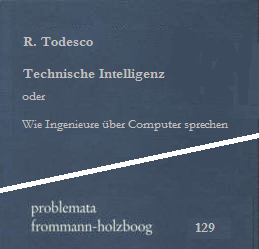
|
||||||||||||
|
Today I want to talk about the engine, which is a technical product and therefore represents that technique, of which I want to speak in the sense of a technology. It is not about the engine, but about how I talk about what - how justifiable. The engine serves as an example of what I want to talk about: about touchable, manufactured objects, which have a mode of operation, which in the case of the engine is somewhat simpler than that of computers, which usually serve me as an example.
ContentsI will first make a few remarks about my observing or speaking, and then say what I call an engine. I will then describe the development of the engine from the point of view of technology and science. ObservationI call the conscious speaking about the making of material artifacts technology, while sciences deal with the rest of the world, which they often call nature. I will begin by describing my subject area in a little more detail, including a few comments about what I do not want to talk about here:
|
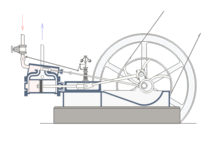
|
||||||||||||
|
I observe here my life world, which I distinguish from other "worlds" in two respects:
|
|
||||||||||||
|
Then I want to say something - also in advance - about my speaking, which is to be an important part of the subject here. That humans speak, I attribute to nature. I can do it, just as birds can fly when they want to. Speaking has a practical use, which I can also observe in communication between (other) animals. I can influence others by speaking under given circumstances. But I don't want to talk about that here either. As speaking I refer here to a setting of writing. I assume that humans first wrote and only later spoke. I do not want to explain that here either. My point here is that writing is a manufacturing activity, whereas with speaking I normally do not manufacture objects. What I say here, I have written down before - observably and touchably. I have produced text, which I set to music here, so to speak. That I could also play this music without a sheet of music, I attribute to nature. As a manufactured object, text, like any artifact, must fulfill a purpose that constitutes its meaning. I cannot form its parts, i.e. letters and words, arbitrarily and arrange them arbitrarily. I must do it sufficiently correctly. In technology this correctness of text appears, for example, in the form of computer programs, where colloquially one speaks of programming "languages" - although no human being speaks a programming language. An important point for me here is that I don't have to understand what I'm doing when I speak. I can just do it. I don't need any science to do it. That I stimulate some nerves in the ears of others by sound waves may be right and true, but it is without any relevance for me here, it is nature. That one can connect thinking and consciousness with speaking is also irrelevant here. When I write, I make tangible objects. Writing is a physical activity that I had to "learn" - euphemistically speaking. I was trained to write beautifully and correctly like a dog. It wasn't about what I was writing, but about the manufacturing craft, which was subject to specific criteria. I had to learn to form material objects as prescribed by syntax.
|
|
||||||||||||
| Writing is a special craft. In writing, I make symbols, material artifacts that stand for something else. That to which I refer I call a reference object. I distinguish between two different kinds of symbolic referencing; I can draw or designate. I can draw any table, but I cannot draw the table. Digital symbols like characters do not show what they stand for.
There are many tables, but the table does not exist. You can say that the word table stands for a mental representation of all possible tables, but nobody can draw or imagine this representation in a literal sense. When I want to explain to someone how I use the word table or any other word, I practically never show him a thing and certainly never a mental representation of a thing, I explain the word by saying other words for it. Every signifying word is a he-sentence for a sentence. This is the procedure I recognize in dictionaries, which are, so to speak, exclusively concerned with just such explanations. A special variant of such explanations I call definition. I define how I use a word by giving a generic term and a criterion. My definitions do not concern things, but show how I use words. Words for which I have a definition I refer to as terms. I always try to use them in a way that I could replace them with my definition. No one has to use words the way I do. How words are used by other people, I can see, what others know is irrelevant or transcendent for me. I cannot know, I can only see what they write. My terms form a network because the words recur in different contexts. My uses of words are viable as long as the network is coherent for me, that is, as long as I can always replace a term with the same he-sentence. In this sense, my explanations have cybernetic constraints that determine what I can say - without contradicting myself - with each particular set of words.
|
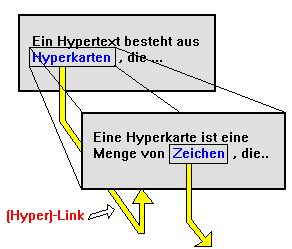
|
||||||||||||
MotorI use the word engine colloquially for all sorts of things, but mostly I think of a car engine. In everyday life, an engine is the thing that is called that. My car has an engine. My drill has a motor, I don't think of my refrigerator as having a motor, and my computer doesn't seem to have a motor at all. But here I am concerned with a definition that I would use in my technology as a he-sentence for the term motor. This term differs from the everyday language word use justified considerably. As motor I designate a manufactured artifact (generic term), with which I can put a wheel without my muscle power into a permanent rotation, thus drive (criterion). The engine gets its sense in the device or in the machine which I drive with it. This is a functional determination. It says what a motor is good for, what I use it for, or what problem I solve with it. But it says little about how an engine is constructed or how it works. An engine - now here I could insert the above beginning - has parts that move relative to other parts of the engine by an action of fuel. This means, for example, a piston in a cylinder that moves due to the expansion of the Bezing mixture. This says some things about the design, but also leaves some things open. |
|
||||||||||||
|
I distinguish two cases with respect to piston engines. In one case I use the propellant to produce steam, and in the other case I use the propellant more directly to cause pressure on a piston by an explosion (deflagration). I want to show first with two examples what my definition includes, respectively excludes, and then say something about the genetic development of the engine. The so-called steam engine, which is often attributed to J. Watt, is - according to my definition - not a machine, but - contrary to its name - an engine. I use it to drive a machine, which is the defined function of an engine. Every machine has a tool function, the motor, however, just not. The so-called electric motor is - according to my definition - not a motor, it is not operated with fuel. It is part of a complicated structure, which I will come to in connection with the development of the engine. The typical engine, apart from the largely extinct steam engine, is the internal combustion engine, which requires gasoline and which many people hope will also soon become extinct. I suspect that with these simple remarks I have already made it clear that even simple things can be talked about in very different ways. I even suspect that many of you do not agree at all with what I have said so far about the engine. So I want to remind you again that it is about how each of us speaks. I assume that we all have our own formulations, which only comes to light when we make our terms explicit. I am very interested in how other people define motor. Unfortunately, I don't know many who do. Most probably don't recognize a problem with the word - unless they are talking to me. The genetic developmentAs announced, I want to say something about the development of the engine, paying particular attention to what I call technology, and to what extent science has contributed. In doing so, it will inevitably become clearer what I call science. I describe here no history, but a genetic development history, in which the temporal occurrence of certain inventions is irrelevant. It is not about inventors, but about a fact-logical development. Artifacts move
|
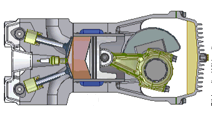
|
||||||||||||
|
As germ forms of the engine I recognize retrospectively all procedures, by which I move artifacts, because I do exactly that with the engine. I observe here only movements of artifacts that I cause willfully. I do not consider an artifact that moves virtually by itself, for example by falling off a table, here any more than I consider a bird flying by. I move a material artifact when I change its position or its orientation in space. An artifact does not want to move, I move it. A ship, for example, I can move by rowing, by using a sail, or by using an engine. The different possibilities are equivalent in this respect: I always move the ship. Not the engine moves the ship, I move it by means of an engine. I describe the history of development of intentional object movements by means of examples and start with the simplest case: I put a raft in a river, which makes the made raft move. I call the raft a technique, I cannot see what any science would contribute to it. That the raft floats in the river I know as experience. I could make it a phenomenon by looking for an explanation for it. By making a raft, I have suspended the phenomenon: I know what I am doing how and for what purpose. This is what I call technology.
|
|
||||||||||||
|
On a lake the raft, which has become a ship because I built it accordingly, does not move. I can row. I can use a sail and use the rudder to steer. I don't need science for that either. With the sailing ship, I can go against the wind with the wind, but I need wind, which I cannot make. The wind is a natural flow. The wind does not move because it has no body, it flows or blows. Why the wind moves my sailing ship, I could make the phenomenon. But the sailing ship I made, it is an artifact moved by me, it is technique. Every movement of a solid body meant here has the cause in the fact that this body is specifically coupled with its environment or a part of it. Every movement of an artifact is coupled to a natural flow, which does not concern any artifact. I refer to the movement of the sailing ship as being structurally coupled to the wind. I can easily see that the wind is the cause. For this I do not need the slightest knowledge of physics and no explanations of where the wind comes from. If I move a hammer, this is coupled with my arm movement by the fact that I hold it in the hand. I also recognize this without any physics. It doesn't technically matter why the wind I use to move my sailing ship is blowing, or why I can couple that flow in the air with the movement of an artifact. Technically, the key is that the wind moves the ship if I place the ship appropriately here and into the wind. Otherwise, I would not place a ship in the wind. Pseudomotor
|
|
||||||||||||
|
I set the windmill and the waterwheel in motion like the sailing ship or the raft by placing them in the corresponding natural river. I move with it the primary wave of a drive, by using a river beyond the manufactured drive. The so-called windmill is also based on a peculiarity of colloquial terms. I do not speak of a windmill, but of a mill, while I speak of a water wheel, even where it drives a mill. The everyday language reflects that wind wheels do not look like wheels. Both "wheels" have taken more developed forms in technology. Here I speak first about the simplest stages of development. I call drive mechanisms, which contain wind or water wheels, pseudo motors, because they serve the drive of machines like motors and also consist of components, which move relative to each other - like those of an actual motor. The mediation to the machine consists in the fact that a component is driven with a transmission, that is, that the device is not moved as a whole as in the case of the sailing ship. By means of appropriately constructed drive mechanisms, I can reload the movement of a shaft, for example by means of belts, chains, gear wheels, connecting rods, etc., at will, i.e. drive a machine. Therefore, I consider here only the drive of the shaft. In the early days of factories, water wheels were used to move many machines, for example looms. There are quite elaborate transmissions. And there is a so-called water art, which leads the water to where it is needed. But the river, in which rainwater flows to the sea, is relatively localized. I have to get the water wheel to the river. Also wind wheels are - apart from their inverse version as propellers - location-bound, although the wind blows almost everywhere, which makes sailing possible. The nature meant here shows up complementary, as effect cause of the technical movement. It is what I use for the function of the drive. Technically, I can control the flow of water through a rack. I can make water flow on a water wheel. I can't do anything to make it flow, I can only partially prevent or direct the flow. And of course I don't have to use the river. Rainwater also flows into the sea, if I don't use it to drive movements. I don't recognize any senseless consumed energy in it. In a bicycle, for example, I move the drive by turning a shaft through my muscle power, in a göpel - a kind of running wheel - through the power of an animal. The drive mechanism is technically independent of the motor, but necessary for motors according to my definition. In the case of the so-called treadle sewing machine, which is not a machine because it has no motor, but is called a machine like the steam engine, motor probably means that it could be driven by a motor according to its design. Pseudo motors replace my muscle power, but I can't move them. I have to bring the machinery to the engine. Exactly these limitations, which come with the river water and the wind, are compensated by the development of the technology on a higher level by the actual engine. To put it bluntly, the pseudo engines don't consume fuel - that's their problem.
|
|
||||||||||||
The actual engineIn the actual engine, I use a fuel to make a part of the engine - typically, but not necessarily, a piston - move. I'll observe the development using the piston steam engine as an example. Before that, however, I want to say something about the "steam engine" in philosophical science. H. Arendt has written: "What was new was not the steam engine, but rather the discovery and exploitation of the coal deposits of the earth, through which one finally gained the fuel to apply the principle of the steam engine. The most essential precondition of the industrial revolution [was] the discovery of coal as fuel. The steam engine was only a logical consequence of it. R. Barrow said that the industrial development in antiquity did not get beyond a certain point, not because they did not know how to invent machines, but because there was no fuel, no coal, for such machines. There are many drawings attributed to some ancient Greeks that show machines. Some of you may remember my standard example: the temple of Heron. What H. Arendt ignores is that coal makes industrial sense only since it is mined industrially - that is by the proletariat. Industry that exploits cheap coal is a social relation, I am not interested in that here. That coal functions as an energy source is a physical, i.e. scientific, observation. Technologically, it has no relevance. Coal is not produced; like wind, it exists in nature. That I can heat with coal, I know beyond any science. Technologically, I am concerned with the artifacts in which I use coal and how. I distinguish whether I use coal to maintain an open fire to heat a cave, or whether I use coal to heat a steam engine. The development of the actual engineWith respect to the actual engine, I distinguish between two cases. In one case, I use the fuel to create steam, and in the other case, I use the fuel more directly to cause pressure on a piston through an explosion (deflagration) of the fuel.
|
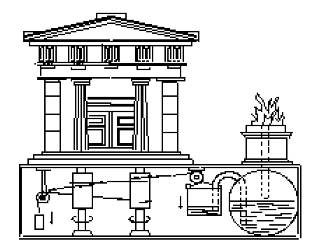
Quelle: Wikipedia |
||||||||||||
|
In a logical-genetic history I observe, for example, how the utilization of the fuel in the development of the engine moves from an external heating into the engine and is cancelled there in a deflagration. In such a history, the simplest germinal forms of the "steam engine" are not only not machines, they also do not drive a machine. The pressure cooker of D. Papin - which is called the first steam engine in many histories of technology - is a device with which nothing is driven and nothing is worked. It is a very special heater. T. Savery's steam engine, which is also often referred to, is a pump in which no parts are driven. The next steam engine commonly considered in such arbitrary stories is that of T. Newcomen. The atmospheric steam engine of T. Newcomen was also used as a pump. It was an actual engine in the sense that it was driven by a steam engine that moved a piston and thus drove a shaft. It was considerably more efficient than that of T. Savery, but again that is not of interest here. Technologically interesting is that T. Newcomen's engine uses gravity as a drive, so to speak. The steam is used to lift the piston, which is then pushed down by the air pressure, because the cooled steam creates a vacuum. This cycle is similar to the water cycle that drives a water wheel. There, the heat of the sun raises the water in the form of steam before gravity causes it to fall back down in the form of water and drive the wheel. The ways of the designers often seem unfathomable. At this point, I will only briefly note that my presentation is and remains incomplete in various respects. I have already said that the ancient Greeks already knew that you can move things with steam. They even knew different types of drive. Heron constructed a heated ball, which turned by recoil and set a shaft in rotation. This construction is not a motor in the sense meant here, because not parts of it move, but the whole apparatus. But it is a propulsion technique, which F. Verbiest used already around 1670 as a drive for his car, and which is used today as a rocket drive. Rockets also have no engine, it would be of no use in space. I will not go into that in detail here.
|
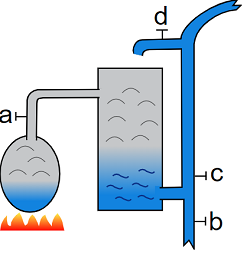
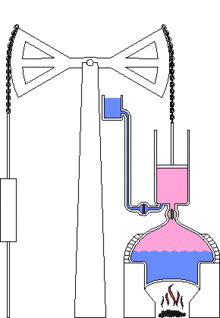
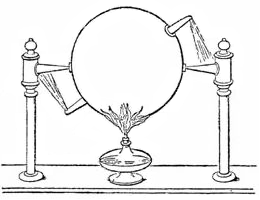
Bildquelle: Wikipedia |
||||||||||||
|
In terms of the engine, the steam engine is a practically extinct intermediate in development. However, I will come back to the medium steam in connection with the turbine in more detail. Here I want to conclude the development first with the internal combustion engine. In the so-called internal combustion engine, the fuel is used more directly. The fuel is mainly refined petroleum, i.e. a mixture of substances that burns very quickly when properly prepared and expands very strongly in the process. I also want to make a remark about this in everyday language. Combustion is a peculiarly chosen expression because, of course, coal is also burned in a steam engine. In English, the term engine just seems to denote that unlike engine is not a steam engine. Ambiguous English often has more distinctions than German. Conversely, the term combustion indicates that it is not an explosion. There are also explosion engines, but I will not go into that here. It seems important to me that with the internal combustion engine, of which there are also all kinds of different variants not mentioned here, a development has been completed in which fuel consumption has migrated completely into the engine. This concludes the development of the actual engine, but of course not the development of the propulsion technology. In addition to the engine, there are also jet engines, which I will come to later - when time permits. But first I want to continue with the so-called electric motor, which I colloquially also call an engine.
|
|
||||||||||||
The motor structureIn the technical development, there is initially a phase in which the use of the fuel migrates into the engine, while it was initially relatively separate from other parts of the engine. It is a matter of increasing integration. In Watt's steam engine, I can still easily distinguish the two parts. In one part, the fuel is used to produce steam, and in the other part, the steam is used as the motive medium. This separation is eliminated in the gasoline engine. As engine-structure I call a result of a reverse development, which I call differentiation or specialization. As engine-assembly I designate an assembly of spatially separated parts, which functionally replaces an engine. Motor assemblies are based on a technical development in which functional units of the motor are separated and connected by media. This decomposition is especially given in electric motors, whose metaphorical "fuel" neither burns in the motor nor moves a piston.
|


|
||||||||||||
The so-called electric motorI will first say in a colloquial sense what the so-called electric motor is, which I use for example in a drilling machine. This electric motor is a device, in which a magnetic field is generated by current in a conductor coil, whereby a shaft is driven. This electric motor is the complementary counterpart to the very similarly constructed generator, with which I generate electric current due to the movement of a shaft. The artifact - the supposed electric motor - does not show what electricity is, but it shows as a construction how a wave is moved with it, i.e. which parts formed in what way have to be arranged. Like the flowing water, I consider the electric current as a phenomenon, which I attribute to nature. I must put the supposed electric motor in a current, which I must bring forth, however, before, because it does not flow down like water naturally anyway. Conventionally, the electric motor is referred to as a transducer that "converts" electrical power into mechanical power or kinetic energy. This corresponds to a popular conception, which reaches far into physics, according to which one can convert energy. It is also associated with the popular notion that energy can be consumed. That is why this electric motor is often called an electric consumer. The current functions in the motor structure, which I call a structure because it consists of several parts, as a medium, which serves me - like the steam in the steam engine - to move the shaft. My drilling machine is driven in this sense by a total engine, whereby the so-called electric motor within the drilling machine is only a part of the engine, which corresponds approximately to the cylinder with the piston of a steam engine. The electric current is seen in a colloquial sense as a kind of fuel. In the case of the steam engine, on the other hand, coal is seen as the fuel, not steam, even in colloquial language. The colloquial language is probably based on the fact that I buy coal, not steam, while I get an electricity bill. In propulsion, however, steam serves as a medium just like electricity. I will first say something about electricity and then go into the function of the medium.
|
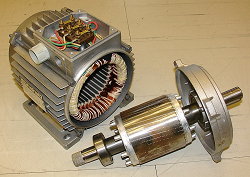
Bildquelle: Wikipedia |
||||||||||||
The electric currentI call a current a substance flowing in a circle divided into two parts by a source and a sink. The water flowing from the source to the sink is no fuel, but I can drive a water wheel with it. In a metaphor I speak of the electric current, which I then also imagine as flowing fluid. With the electric current I can drive a wave. I don't need to know what electricity is and I don't need any science. All I need is a very naive, vivid image of an invisible stream with which I can move something. Just like steam, I can use electric current not only to drive a shaft, but in a wide variety of devices that don't have a shaft. I can heat with electricity or make a filament glow. But that does not interest me here. Here I am only interested in the motor. The function of the mediumThe medium allows me to break the engine into separate parts and connect them functionally. For example, I have a generator, a wire, and a machine drive, as separate artifacts that I can replace individually. The engine is made up of more different parts in different places that perform different functions. In hydraulic drives, oil under pressure acts as the medium. This allows me, for example, to move an excavator shovel that is relatively far away from the compressor that I drive, for example, by means of a gasoline engine. In hydraulics, the oil flows in an analogous sense to the stream in the sense of a metaphor, that is, not like the water in a stream. I refer to gasoline, for example, as fuel because I can use it to drive an engine. If I want to generate steam or electricity, I can use a fuel to do so. I can use steam and electricity to drive engines, but I don't call them fuels, I call them media. I cannot mine steam and electricity like natural fuels, they are not available like that in nature. I have to produce them through technology. Unlike fuels, they cannot be stored. To put it more pointedly: The output side of the electric motor (i.e. the colloquial electric motor), like the pseudo-motor, does not consume fuel - that is its problem. You can't take the electricity with you - like gasoline, for example. The simple solution to the problem - which is by no means simple technically - is the overhead line on the railroad. I don't want to make this problem up. But I do know, of course, that military aircraft are refueled in the air because they can't carry enough gasoline, and that the gas station where I fill up with gasoline is not connected to the source by a pipeline. I get electricity at home, for gasoline I have to drive to the gas station.
|

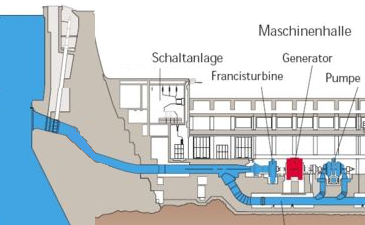
Bildquelle: Wikipedia 
Bildquelle: Wikipedia |
||||||||||||
The actual or the whole electric motorThe actual electric motor, i.e. the motor structure as a whole, finally drives a shaft like an actual motor. I do not want to go into the different variants here in detail, but only observe in how many ways the already thematized techniques reappear through the medium of electricity in a new function within the structure. Essentially, it is a matter of separating the generation of electricity, the flow of electricity and the use of electricity to drive machines. In a very common case I use a water wheel. However, I do not use the waterwheel to drive a machine, but a part of the electric motor, which I call a generator, through which I generate the flow of current, i.e. a kind of fludium. This disadvantage is relatively cancelled out in the electric motor, which contains a generator, by the medium of electricity, because I can make the current flow where I need it. The drill of my drilling machine moves everywhere where I can connect it to electricity. In the case given here, however, the drill moves because of the natural flow of water from a reservoir, which I mediate in the medium. The actual electric motor uses the natural motion I use in the pseudo motor and the actual motor indirectly. The generatorThe generator is only one way to produce electricity and moreover I can move the generator in very different ways. In the hydroelectric power plant, I use the flow of water to drive the generator waterwheel, which, however evolved, still acts as a waterwheel. But I can also drive the generator in other ways. I call the generator on my bicycle a dynamo. I drive it by moving the transmission through my pedaling. Thereby I renounce the natural movement beyond a living being, so that I cannot speak of a motor at all. The example shows however that I can recognize the development, which I described above, also on this level. In the so-called hybrid drives in cars, the generator is driven by the gasoline engine and partly by the so-called recuperation, which works like a dynamo. Moreover, the dynamo shows that the generator is not bound to a location. The generators are very often driven by steam. This is typically the case in a nuclear power plant or a coal-fired power plant. In these cases I use actual engines as parts of an engine structure. The inversion(s)In the actual electric motor, I can not only drive the generator differently. I can also use the generated current in different drives. In most cases of interest here, electricity is used to drive the shaft of the colloquial electric motor. But there is also the hydrogen engine, for which the electricity is used to produce the fuel hydrogen, which corresponds to an inversion of the indirectly fuel-driven generator, which in turn has a kind of inversion in the fuel cell, about which I will say something later.
|
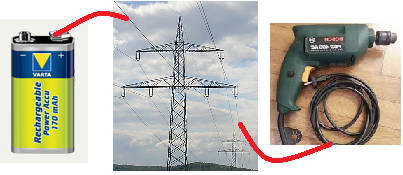
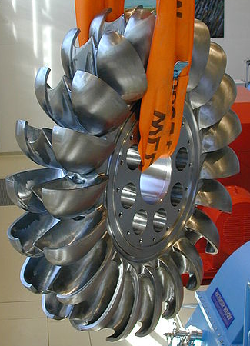

Bildquelle: Wikipedia |
||||||||||||
Electricity productionThe production of electricity by generators has found M. Faraday. He is praised as a natural scientist. But - in this context - he neither invented nor discovered electricity nor explained it in a physically profound way, he constructed a device. Of course, one can neglect the device and speak of an experiment - but even then it has nothing to do with science: it is the invention of a technique that can be used to generate electricity. There are very different ways to produce electricity. I will not go into the history here, but just mention two different processes that are very important in today's technology. One is the battery, the other is the semiconductor in the so-called solar cell.
|
|
||||||||||||
The batteryI have an explanation of what happens in a battery. For this I have to make some assumptions about so called electrons and their distribution in atoms. Both I have never seen before. Both do not occur in my life world. Independently of any explanation, I can produce a phenomenon which I call electricity production. For example, I can hold two plates of different metals in a container of acid and connect the two plates with a wire to a light bulb. The lamp glows, which I perceive as light, and explain with a flow of electricity, because I can also make the lamp glow with electricity. My explanation includes that as part of a chemical reaction, electrons are separated and then flow through the wire connection until equilibrium is restored. I may think my explanation is great and important, but I can use the light independently to see something in the dark. I call the whole thing a lamp, which I make glow by means of a battery. I can't store electricity, but I can pump water into a reservoir and I can cause the chemical battery process by bringing the appropriate material together in the right proportions and connecting it through conductive material. The materials I need for a battery I can mine and store in nature like fuel. I cannot manufacture the chemical process, it is a natural phenomenon that I can reproduce, just as I can always burn wood or coal to generate heat. In an inversion of the process, I can use electricity to produce the battery's starting materials. I refer to this process as an accumulator. Colloquially, we speak of energy storage rather than electricity storage.
|
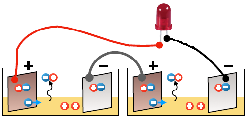
Bildquelle: Wikipedia |
||||||||||||
The solar cellThe so-called solar cell is also based on a chemical process in which semiconductor material acts as a catalyst, in which the radiation of the sun triggers a current. Colloquially - typically in Wikipedia - it is said that sunlight is directly converted into electrical energy. This is like saying that sunlight is converted into the falling water of a hydroelectric power plant. Such ways of speaking are based on a popular concept of energy. Conversely, they show that it is not necessary to understand anything about physics. The methods were discovered in the beginnings of the observation of electrical phenomena in the middle of the 19th century. Because they had no recognizable application at the time, they were colloquially referred to as science. In retrospect, i.e. in a history of development of technology, they are procedures of electricity generation, which are also used in actual electric motors. Here, the main interest is that by disassembling the motor, individual parts can be replaced by other processes, which often also leads to the fact that original problem, such as that I can not store electricity, at least partially canceled.
|
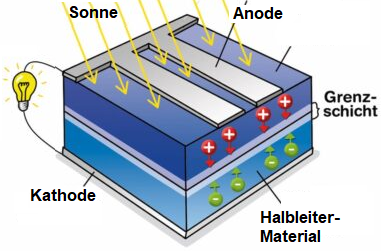
Bildquelle: Wikipedia |
||||||||||||
TechnologyObserving the development of the engine serves me here exemplarily as a language game, on the basis of which I observe my theory. The development of the engine is sufficiently complicated to provide sufficient material for the language game, and on the face of it the engine is simple enough to keep the concepts coherent. The technology I am unfolding here is ostensibly a doctrine concerned with artifacts in which efficient procedures are suspended. However, as stated in advance, it is not concerned with the production of these artifacts. That is what engineers are concerned with. It is about what I describe or talk about and how, that is, about what I observe. I've already talked about my life world. I want to emphasize again that in the micro- and in the macro-world there are only a handful of objects each - atoms and stars - which assume a handful of states each. In my life world, however, I distinguish innumerable objects, of which countless many take countless many states. No human being can tell them. Carl von Linné for example has developed a classification. He considered only plants and animals without giving reasons for his categories. He also did not give plausible reasons for his classes. In the meantime, genes are used, which does not make the scientifically meant thing better, but connects to the technology of the so-called gene manipulation (bioengineering). In my technology I observe - like C. von Linné - not simply everything, but the making, because I recognize exactly in it my being, which I recognize in the expressions "Homo faber" or "toolmaking animal". Manufactured objects have a purpose, which I call object meaning. I have no idea what God separated heaven and earth for, what He invented water and elephants for. I know that many people prefer to speak of nature rather than God. But I also don't know for what purpose nature has produced an elephant, or human beings, or their language - but I do know how and for what purpose I make a hammer or a sickle, or an engine. I don't want to talk here about what technology is good for, but I want to show that the concepts of technology have reference objects that I can grasp in the sense that I can touch them with my hands. In doing so, I do not need to thematize anything otherworldly, but can show how I make the designated objects in a way that can be comprehended by others. I need thereby constructions, not mental constructs. I thus create a comprehensible language game whose limits I remain aware of at all times. Cybernetics is in this sense an exemplary technology. I explain all phenomena to myself cybernetically and as a phenomenon comes into consideration exactly in this sense what I can explain cybernetically. To explain something - not to explain something to somebody ! - means to construct a mechanism with which I can produce the phenomenon to be explained.
|
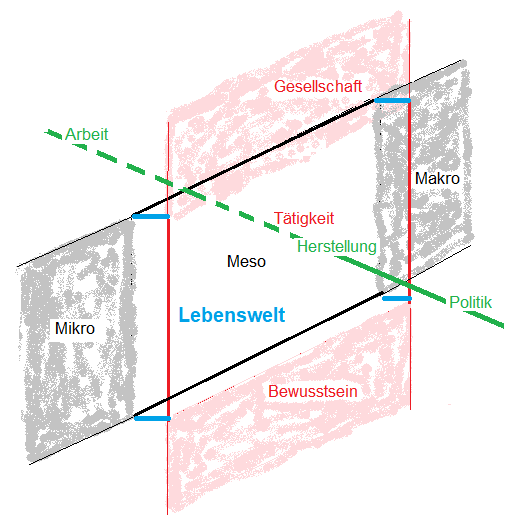

 |
||||||||||||
ScienceNow I want to say something about science. In my life world it plays directly no role, I never need it. Science describes what is neither experienceable nor testable (hypothetically) the case. Indirectly, however, science plays a rhetorically extreme role in politics - which shows up in my life world as discussion. Ever since the so-called Enlightenment introduced the republic, politics, previously decided by secular or ecclesiastical nobles, has been discussed, with scientific arguments being called in. Science is highly relevant in this Luhmannian sense as a component of political "communication." As science I refer in a broad, still undifferentiated sense to philosophy, which I ascribe in the Renaissance sense to the ancient Greeks, who kept slaves and knew about everything. The first difference I recognize in logic, from which mathematics - and in particular its by far most important part, statistics - emerged. The philosophy disintegrated into two separate areas. The second difference I recognize in the natural science, which G. Galilei brought to the point: Measure what is measurable, make everything else measurable! Measuring is first of all an everyday activity in my life world. But that is not what G. Galilei did not mean, of course. He meant what K. Popper brought to the point a little later: the falsification of hypotheses. I often hear that experiment is the essence of science. Experimentation, like measurement, is an everyday activity in my life world. It has about as much to do with science as scientists need oxygen to live. I call "working" with fictitious hypotheses science. G. Galilei's exemplary fiction was that of the free fall, which he could not observe, let alone measure. G. Galilei was one of the first (the first known to me) to deliberately invent fictitious, ideal laws. The fiction of free fall requires indulgence to air resistance or friction. Cardinal Bellarmino said: Be reasonable: call your ideas hypotheses, otherwise they are heresy. Newton: Hypothesis non fingo, but that does not interest scientists today. Science is - apart from the totally arbitrary, random hypotheses according to K. Popper - an application of technology. With Galilei the telescope, today the CERN monster. The remaining philosophy has lost a second big part by science. A part was saved by I. Kant with his question about the conditions of possibility, which I call idealism. This philosophy was completely fulfilled by G. Hegel. The residual philosophy, which I call theology, deals with questions that arise under social conditions: Why do some people work for others? Developed people could not ask themselves this question at all. The philosophers have invented consciousness, psyche and society for this purpose - which play no role - or much more precisely a very political role - in my life world. I always pay a lot of attention to who uses such words and when. |
|
||||||||||||